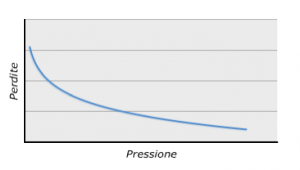The pressures acting on the seals are those caused by the hydraulic pump of the circuit (Pp) and that created by the movement of the cylinder, called “drag pressure” (Pt):
Ptot = Pp + Pt = Pp + K ∙ µVL/s2
where
- Ptot = total pressure
- Pp = hydraulic pump’s pressure
- Pt = drag pressure
- K = constant factor (» 5)
- µ = fluid’s viscosity
- V = speed
- L = length of the surfaces in relative movement
- s = distance between the surfaces

The drag pressure, especially in the case of close fittings, can sometimes be higher to that generated by the pump itself causing early damage to the seal.
During this exercise, the seal element can be subjected to continuous pressure variations that, even if for short periods, often reach very high intensity values.
Those additional loads, that must be held into consideration before choosing the right sealing system, expose the seal to a high operating stress.
Low pressure (less then 50 bar)
Low pressure is the most critical situation for good performance of the sealing system and is the situation where it is possible to have more leakage problems.
In those cases, the sealing lips are not energized enough from the fluid and the oil film between lip and dynamic surface reaches an excessive thickness.
The choice of the right profile and material of the seal can remarkably reduce the leakage risk in this situation.
Medium pressure (50-150 bar)
The pressure range between 50 and 150 bar is one of the most favourable and, in this condition, almost all types of seals guarantee good sealing performance, even if with variable life depending on the material of the seal.
Higt pressure (over 150 bar)
With high pressure conditions or in presence of high peaks (shock loads), the seals normally give very good results: it is the fluid pressure itself that energizes the sealing lips therefore guaranteeing very good sealing performance.
High pressure on the contrary reduces the entire sealing system’s life. In these working conditions, we find lots of wear and extrusion cases that cause early damaging to the seals.
So the choice of materials becomes very important as they must be very resistant to extrusion and wear.



